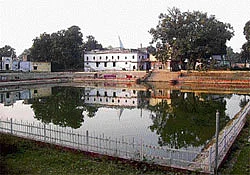
The historical ‘kunds’ (large ponds) in the temple town of Ayodhya, the land of Lord Rama, are known to be associated with the life of Rama and his brothers Laxman and Bharata and the Hindu mythology and are full of stories highlighting their religious importance.
The ‘kunds’ scattered in and around the temple city are frequented by a large number of devotees and pilgrims from across the country. Fairs and are also organised on special occasions.
The ‘kunds' have mythological importance and are revered by the sadhus, saints and the common people. Most of them have anecdotes associated with them. The devotees frequent these ‘kunds’ in large numbers for paying their obeisance. These ‘kunds' carry special names, which signify their religious importance and indicate their close association with Lord Rama and his brothers.
So there is a ‘dantdhawan kund’, which Lord Rama, according to the mythology, used to frequent for washing his tooth. The name ‘dantdhawan’ means ‘washing of teeth’.
The ‘Surya Kund’ at Darshan Bazar near Ayodhya, the sadhus say, was constructed by the king ‘Darshan’, said to be a descendant of Lord Rama. The nearby ‘Surya’ temple and the ‘kund’ are popular destinations for the devotees.
The ‘Khajuha kund’ is said to possess medicinal qualities as the name suggests. According to mythology, the waters of the ‘kund' can cure skin diseases. The devotees, who visit it, make it a point to take bath and leave their old clothes at the pond. Similarly, the ‘Bharata Kund’ near Ayodhya is known to be the place where Bharata had spent years awaiting the return of his elder brother Lord Rama, who had gone to the jungles with Laxman and Sita in deference to the wishes of his step mother Kaikeyi.
Rituals performed
The devotees take bath in the ‘Bharata kund’ and offer ‘pind dan’ (a ritual performed by the Hindus for the departed souls). It is believed that the ‘departed souls attain salvation’ if the ritual is performed here. There are many such ‘kunds’ in the town named after ‘Vibhishana’ (Ravana’s younger brother, who had left Ravana to join Rama), ‘Laxman Kund’ and ‘Sita Kund’ and others.
Unfortunately, many of these ‘kunds’ have been becoming the victims of encroachment by the growing population and have been fighting a grim battle for their survival.
Some of the ‘kunds’ are facing threat from encroachments, while a few have become garbage dumps. Big ‘pucca’ houses and shops have come up on some of the ‘kunds' and the land near them at many places allegedly with the connivance of the civic authorities.
Although the ‘kunds’ are visited by lakhs of devotees almost round the year, the administration does not bother to clean them even on special occasions thus making their waters unfit for bath.
The stench emanating from the waters deter the devotees from visiting them and offering ‘puja’. “Very few people take bath in the Bharat Kund these days owing to the polluted water”, says Rameshwar Das, who lives nearby.
“There used to be a large number of turtles and fish in the kund but now their number is declining sharply...the kund is also becoming shallow because of immersion of idols”, he says.
The authorities say that they did not have budget for undertaking cleaning of the ‘kunds’. Regional tourism officer Rajendra Kumar Rawat said that his department had sent a proposal to the Central Government for renovation of the ‘kunds’ of Ayodhya. “Once the proposal is accepted and the funds are released, the work of renovation of the kunds will be taken up at war footing...their old glory will be restored”, Rawat says.
Unless immediate remedial measures are taken, the historical ‘kunds’ would become a part of history very soon.